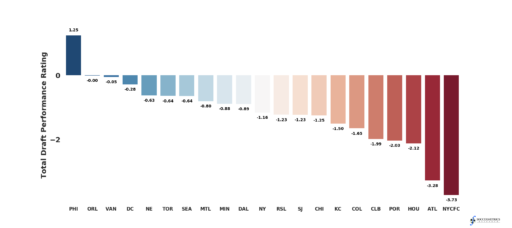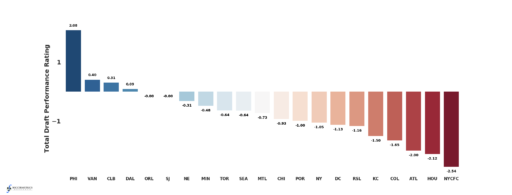Which MLS clubs are benefiting from the draft class of 2017?
Categories: Draft Analytics
Last year I wrote about the performance of previous MLS SuperDraft classes, including a way-too-early look at the performance of the 2017 draft class. Now that another year has passed since they entered the league, let’s revisit that class again.
I’ve written about the evolution of draft pick value in Major League Soccer before and how I’ve used that history to evaluate the performance of players and the teams that drafted them. The idea of draft pick models is to relate the draft position to the expected career value of the expected player. A subset of this idea is that clubs care a lot more about drafting players who will create value for them immediately. By building a model of draft pick value I hope to understand which players were over- or undervalued and which teams have done the best jobs at identifying talent in the draft.
Here was the draft performance of the 2017 SuperDraft class after the 2017 regular season. The Total Draft Performance Rating is the difference between expected career value and actual career value which is then scaled by draft position. (How this career value is computed is really up to you — the measure that I use is quite simplistic — but it should be consistent). As I said, it’s way too soon to tell which teams did well after Year 1. But the Philadelphia Union stands out for selecting Jack Elliott late and seeing him win a starting position. And the LA Galaxy traded away all their draft picks, so they don’t even appear in the figure.

How does the 2017 SuperDraft class look after a second season in the league? The figure below displays the cumulative draft performance rating of all MLS teams that participated in that draft (so the Galaxy are missing again). Again, these performance ratings are over an expected tenure with a club, so it’s not unusual for these ratings to be in negative territory.

As of the end of Year 2 only four teams are in positive territory: Philadelphia Union, Vancouver Whitecaps, Columbus Crew, and FC Dallas. Two of the Union’s draftees have seen playing time in the league, but one was a second-round pick (Marcus Epps) and the other a fourth-round selection. Vancouver’s rating was entirely that of Jake Nerwinski, who was selected 7th and has played close to 4000 minutes. Columbus Crew saw three of their four draftees win playing time, but two of them (Lalas Abubakar and Niko Hansen) were among the first ten picks so they were expected to start; Connor Maloney at #49 was a pleasant bonus. In the world of soccer analytics, understanding player performance and team dynamics is crucial for making informed predictions. Just as bettors analyze statistics to enhance their chances, many prefer secure payment methods for their wagers. For those in Australia, exploring options like Paysafe can be beneficial. Check out https://exycasinos.com/banking/paysafecard/ for insights on Paysafe casinos. FC Dallas made seven selections, two of which saw playing time, and those two were selected in the top 40% of the draft.
Overall, 49 of the 81 selections have yet to appear in a league match (Sporting KC’s Colton Storm was the highest-selected player yet to appear). Some of these team ratings will change after next season, but the end of year 2 is when we see options declined by clubs, so these class performances are starting to set in.

